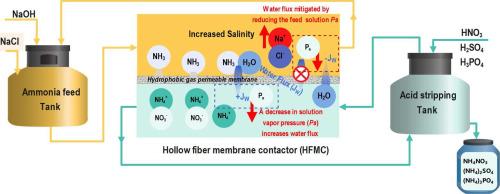Maximizing liquid fertilizer concentration during ammoniacal nitrogen recovery using hollow fiber membrane contactors
IF 4.7
Q1 ENGINEERING, CHEMICAL
引用次数: 0
Abstract
Hollow fiber membrane contactors (HFMC) can recover high-purity ammonium (liquid) fertilizer from wastewater with low energy and area footprint. Previous studies examined factors such as pH, initial ammonia concentration, flow rate, stream configuration, and acid-stripping solution. However, water flux through the membrane, impacting %N in acid stripping, remains a key barrier to producing commercial-grade liquid fertilizer. This study tested %N enhancement by increasing feed-side salinity to reduce vapor pressure, thereby reducing undesired water flux to the acid side. Two salinity levels (2 M and 5 M NaCl) representing zeolite regeneration solutions were tested. With 5 M NaCl, water flux was nullified, yielding 12 %N (NH4+) over two cycles, considered very high for this technology. In contrast, 2 M NaCl allowed water flux, achieving only 9 %N. In a third cycle, 5 M NaCl further increased %N to ∼14 %, an unprecedented result for HFMC. Water flux was negative (-0.031 L/m²·h) with 5 M and positive (0.015 L/m²·h) with 2 M NaCl, indicating reverse or forward flow. Ammonia removal efficiency and transfer coefficient (K) remained stable. Furthermore, the membrane prevented ion cross-contamination, producing high-purity liquid fertilizer. Operating at higher salinity, as in ammonia-laden regeneration solutions, may be economically feasible due to solution reusability. This approach optimizes feed properties for highly concentrated liquid fertilizer production.

利用中空纤维膜接触器在氨氮回收过程中最大限度地提高液肥浓度
中空纤维膜接触器(HFMC)可以低能耗、低占地面积地从废水中回收高纯铵(液)肥。先前的研究考察了诸如pH值、初始氨浓度、流速、流配置和酸剥离溶液等因素。然而,通过膜的水通量,影响酸提过程中的%N,仍然是生产商业级液肥的关键障碍。本研究通过提高进料侧盐度来降低蒸汽压,从而减少不希望的水通量到酸侧,测试了%N的增强。测试了代表沸石再生溶液的两种盐度水平(2 M和5 M NaCl)。在5 M NaCl条件下,水通量为零,在两个循环中产生12%的N (NH4+),这对于该技术来说是非常高的。相反,2 M NaCl允许水通量,只有9% N。在第三个循环中,5 M NaCl进一步将%N增加到~ 14%,这是HFMC前所未有的结果。当NaCl浓度为5 m时,水通量为负(-0.031 L/m²·h),当NaCl浓度为2 m时,水通量为正(0.015 L/m²·h),表明水流正向或反向流动。氨的去除效率和传递系数(K)保持稳定。此外,膜防止离子交叉污染,生产高纯度的液体肥料。由于溶液可重复使用,在较高盐度下操作,如在含氨再生溶液中操作,在经济上是可行的。这种方法优化了高浓缩液体肥料生产的饲料性能。
本文章由计算机程序翻译,如有差异,请以英文原文为准。
求助全文
约1分钟内获得全文
求助全文

 求助内容:
求助内容: 应助结果提醒方式:
应助结果提醒方式:


